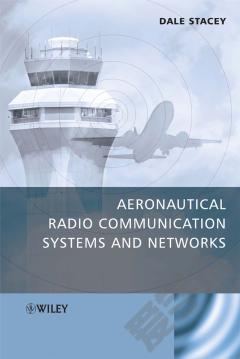Aeronautical Radio Communication Systems and Networks
Preface. Dedications. About the Author. Revisions, Corrections, Updates, Liability. Book Layout and Structure. 1 Introduction. 1.1 The Legacy. 1.2 Today and the Second Generation of Equipment. 1.3 The Future. 1.4 Operational and User Changes. 1.5 Radio Spectrum Used by Aviation. 1.6 Discussion of the Organizational Structure of Aviation Communications Disciplines. 2 Theory Governing Aeronautical Radio Systems. Summary. 2.1 Basic Definitions. 2.2 Propagation Fundamentals. 2.3 Power, Amplitudes and the Decibel Scale. 2.4 The Isotropic Power Source and Free Space Path Loss. 2.5 Radio Geometry. 2.6 Complex Propagation: Refraction, Absorption, Non-LOS Propagation. 2.7 Other Propagation Effects. 2.8 Modulation. 2.9 Shannon's Theory. 2.10 Multiplexing and Trunking. 2.11 Access Schemes. 2.12 Mitigation Techniques for Fading and Multipath. 2.13 Bandwidth Normalization. 2.14 Antenna Gain. 2.15 The Link Budget. 2.16 Intermodulation. 2.17 Noise in a Communication System. 2.18 Satellite Theory. 2.19 Availability and Reliability. Further Reading. 3 VHF Communication. Summary. 3.1 History. 3.2 DSB-AM Transceiver at a System Level. 3.3 Dimensioning a Mobile Communications System-The Three Cs. 3.4 Regulatory and Licensing Aspects. 3.5 VHF 'Hardening' and Intermodulation. 3.6 The VHF Datalink. Further Reading. 4 Military Communication Systems. Summary. 4.1 Military VHF Communications - The Legacy. 4.2 After the Legacy. 4.3 The Shortfalls of the Military VHF Communication System. 4.4 The Requirement for a New Tactical Military System. 4.5 The Birth of JTIDS/MIDS. 4.6 Technical Definitionof JTIDS and MIDS. 5 Long-Distance Mobile Communications. Summary. 5.1 High-Frequency Radio - The Legacy. 5.2 Allocation and Allotment. 5.3 HF System Features. 5.4 HF Datalink System. 5.5 Applications of Aeronautical HF. 5.6 Mobile Satellite Communications. 5.7 Comparison Between VHF, HF, L Band (JTIDS/MIDS) and Satellite Mobile Communications. 5.8 Aeronautical Passenger Communications. Further Reading. 6 Aeronautical Telemetry Systems. Summary. 6.1 Introduction - The Legacy. 6.2 Existing Systems. 6.3 Productivity and Applications. 6.4 Proposed Airbus Future Telemetry System. 6.5 Unmanned Aerial Vehicles. 7 Terrestrial Backhaul and the Aeronautical Telecommunications Network. Summary. 7.1 Introduction. 7.2 Types of Point-to-point Bearers. 7.2.10 Hybrid Network. 8 Future Aeronautical Mobile Communication Systems. Summary. 8.1 Introduction. 8.2 Near-term Certainties. 8.3 Longer Term Options. Further Reading. 9 The Economics of Radio. Summary. 9.1 Introduction. 9.2 Basic Rules of Economics. 9.3 Analysis and the Break-even Point. 9.4 The Cost of Money. 9.5 The Safety Case. 9.6 Reliability Cost. 9.7 Macroeconomics. 10 Ground Installations and Equipment. Summary. 10.1 Introduction. 10.2 Practical Equipment VHF Communication Band (118-137 MHz). 10.3 Outdoor. 11 Avionics. Summary. 11.1 Introduction. 11.2 Environment. 11.3 Types of Aircraft. 11.4 Simple Avionics for Private Aviation. 11.5 The Distributed Avionics Concept. 11.6 Avionic Racking Arrangements. 11.7 Avionic Boxes. 11.8 Antennas. 11.9 Mastering the Co-site Environment. 11.10 Data Cables, Power Cables, Special Cables, Coaxial Cables. 11.11 Certification and Maintaining Airworthiness. Further Reading. 12 Interference, Electromagnetic Compatibility, Spectrum Management and Frequency Management. Summary. 12.1 Introduction. 12.2 Interference. 12.3 Electromagnetic Compatibility. Process. 12.5 Frequency Management Process. Further Reading. Appendix 1 Summary of All Equations (Constants, Variables and Conversions). Appendix 2 List of Symbols and Variables from Equations. Appendix 3 List of Constants. Appendix 4 Unit Conversions. Appendix 5 List of Abbreviations. Index.
{{comment.content}}








 京公网安备 11010802027623号
京公网安备 11010802027623号